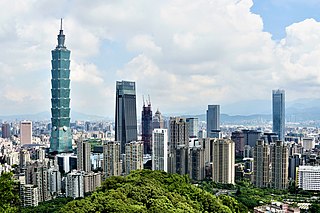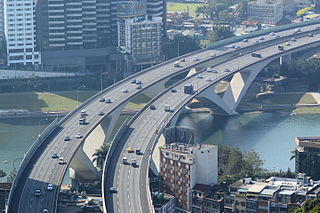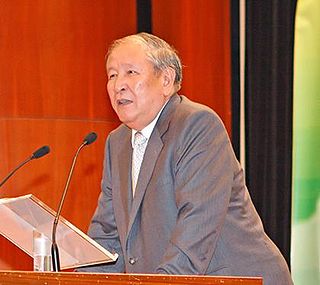
Taiwan,officially the Republic of China (ROC),is governed in a framework of a representative democratic republic under a five-power system first envisioned by Sun Yat-sen in 1906,whereby under the constitutional amendments,the President is head of state and the Premier is head of government,and of a multi-party system. Executive power is exercised by the Executive Yuan. Legislative power is vested primarily in the Legislative Yuan. Taiwan's judiciary is independent of the executive and the legislature. In addition,the Examination Yuan is in charge of validating the qualification of civil servants,and the Control Yuan inspects,reviews,and audits the policies and operations of the government.

Taipei,officially Taipei City,is the capital and a special municipality of Taiwan. Located in Northern Taiwan,Taipei City is an enclave of the municipality of New Taipei City that sits about 25 km (16 mi) southwest of the northern port city of Keelung. Most of the city rests on the Taipei Basin,an ancient lakebed. The basin is bounded by the relatively narrow valleys of the Keelung and Xindian rivers,which join to form the Tamsui River along the city's western border.

The February 28 incident was an anti-government uprising in Taiwan in 1947 that was violently suppressed by the Kuomintang–led nationalist government of the Republic of China (ROC). Directed by provincial governor Chen Yi and president Chiang Kai-shek,thousands of civilians were killed beginning on February 28. The incident is considered to be one of the most important events in Taiwan's modern history and was a critical impetus for the Taiwan independence movement.

Presidential elections were held in Taiwan on 20 March 2004. A consultative referendum took place on the same day regarding relations with the People's Republic of China.

Peace Memorial Day,also known as 228 Memorial Day,is a public holiday in Taiwan for honoring and mourning the victims and families of the February 28 incident in 1947. Proposals to establish Peace Memorial Day as a holiday began in the early 1990s. It was passed as a national memorial day in 1995 and as an official public holiday in 1997.
Highways in Taiwan are classified into five types:

National Freeway 3,also known as Formosa Freeway,is a freeway in Taiwan. It is the second north–south freeway in Taiwan,beginning in Keelung City at Jijin Interchange on the provincial highway 2 and ending in Linbian,Pingtung on the provincial highway 17. It is the longest freeway in Taiwan with a total length of 431.5 km (268.1 mi). The freeway is also the only one in Taiwan to have a spur route,Freeway 3A.

The Baltic Way or Baltic Chain was a peaceful political demonstration that occurred on 23 August 1989. Approximately two million people joined their hands to form a human chain spanning 690 kilometres (430 mi) across the three Baltic states of Estonia,Latvia and Lithuania,which at the time were occupied and annexed by the USSR and had a combined population of approximately eight million. The central government in Moscow considered the three Baltic countries constituent republics of the Soviet Union.

Ketagalan Boulevard is an arterial road in Zhongzheng District in Taipei,Taiwan,between the Presidential Office Building and the East Gate (東門). It is 400 meters (1,300 ft) long and has five lanes in each direction with no median.

Million Voices against Corruption,President Chen Must Go (百萬人民反貪腐倒扁運動) was a Taiwanese mass campaign led by former Chairman Shih Ming-teh of the Democratic Progressive Party to pressure then-President Chen Shui-bian to resign in 2006.

The following outline is provided as an overview of and topical guide to Taiwan:
Articles related to Taiwan include:

Ng Chiau-tong was a Taiwanese pro-independence activist who served as the chairman of the World United Formosans for Independence (WUFI) until his death in 2011.

Yu Cheng-hsien is a Taiwanese politician. He was the Minister of the Interior from 2002 to 2004.
Events from the year 2014 in Taiwan,Republic of China. This year is numbered Minguo 103 according to the official Republic of China calendar.
Events from the year 2004 in Taiwan,Republic of China. This year is numbered Minguo 93 according to the official Republic of China calendar.

The New Power Party (NPP) is a political party in Taiwan formed in early 2015. The party emerged from the Sunflower Student Movement in 2014,and advocates for universal human rights,civil and political liberties,as well as Taiwan independence/nationalism. The party is a part of the political phenomenon known as the "Third Force" (第三勢力),in which new political parties,unaligned with traditional Pan-Green or Pan-Blue Coalitions,sought to provide an alternative in Taiwanese politics. Nevertheless,the NPP's policies are very much aligned with and closely match the Pan-Green camp;thus the NPP cooperated with the Democratic Progressive Party (DPP) against the Kuomintang (KMT) in the 2016 elections,going as far as not to run in traditional KMT strongholds to avoid competition with the DPP. The party works in tandem with a perceived generational shift towards Taiwan-centrism as the new socio-cultural norm.

Chung Chia-pin is a Taiwanese politician. He served on the National Assembly from 1996 to 2000. He was elected to the Legislative Yuan in 2016.

The Hong Kong Way was a peaceful political campaign held in Hong Kong on 23 August 2019,the 30th anniversary of the Baltic Way. The goal was to draw people's attention to the 2019 anti-extradition bill movement and the protesters' five demands for government accountability and democratic reform. Organisers estimated that 210,000 people participated. In the early night time hours,Hongkongers joined hands to create a human chain of 50 kilometres long on both sides of Victoria Harbour,along the three main MTR lines and over the top of Lion Rock,without any disruptions to traffic.

Chou Chun-mi is a Taiwanese politician and lawyer who is currently Magistrate of Pingtung County,serving since 2022. A member of the Democratic Progressive Party (DPP),she served in the Legislative Yuan from 2016 until 2022.
















